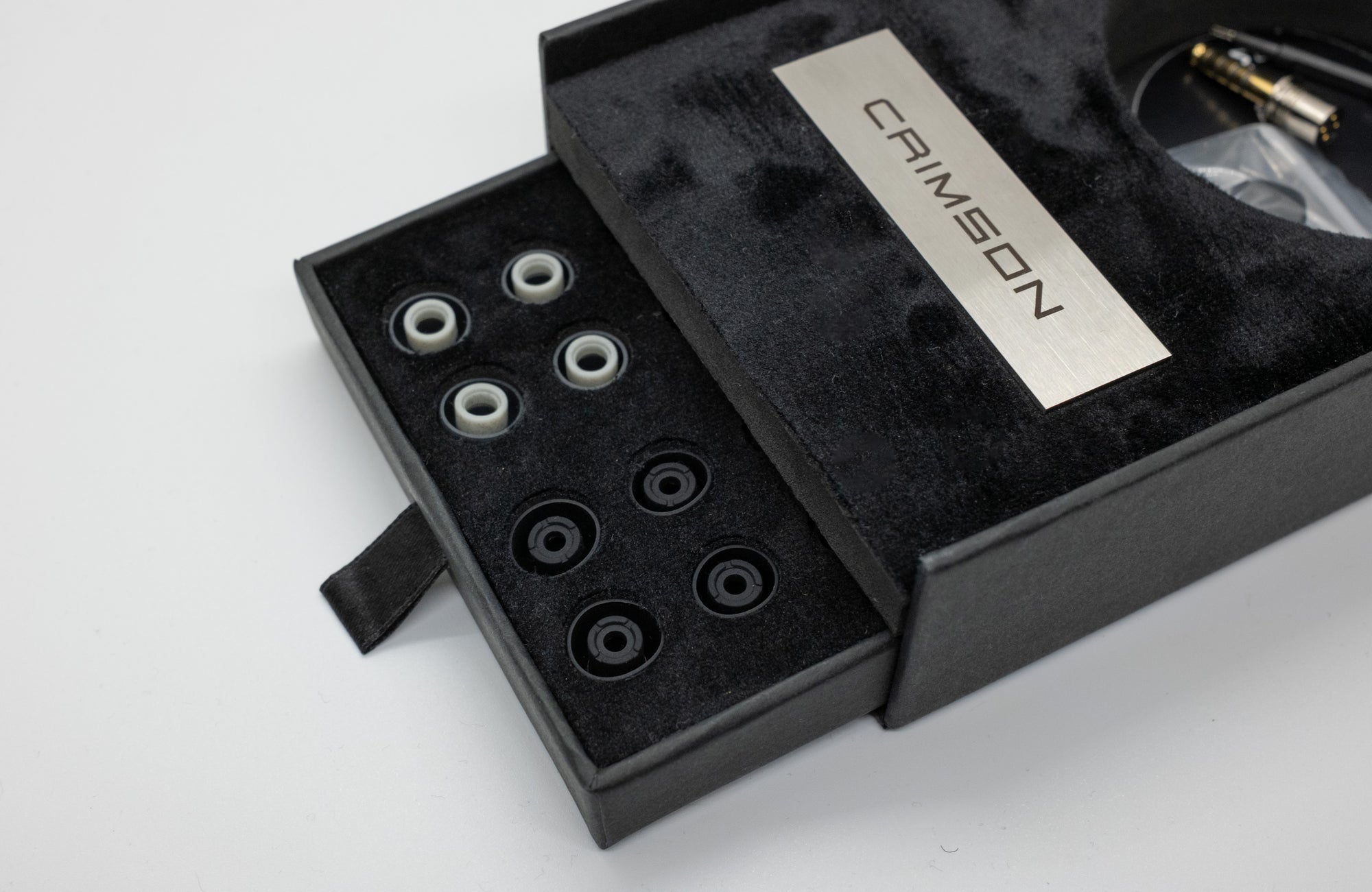Symphonium Crimson Review - Precog's Take
<span data-mce-fragment="1">Symphonium is a small Singaporean IEM brand that has been making bigger waves. The Crimson is the brand's latest release, as well as their new flagship IEM. After several listening sessions with the Crimson, Precog discusses how it stacks up. </span>

Photography by Chitoh Yung (@chitohgraphy)
Introduction
Symphonium is a small Singaporean IEM brand that has been making bigger waves. The IEM that originally put them on my radar was the Helios which I reviewed a couple years ago and declared to be the ‘brightest kilobuck star’. Basically, it was a shining example of what is possible with a low-driver count BA configuration - albeit in a fairly large shell. Since then, the brand has stuck to their guns with the low-driver count ethos, working to improve ergonomics, and the Crimson (4BA) is their latest model. At $1500, the Crimson is also their most expensive model that’s playing squarely in the flagship arena.
I’ve listened to multiple units of the Crimson over the past several months: first in Singapore, then at CanJam SoCal 2023, and then from my own home with a loaner unit. Let’s finally take a closer listen at how it stacks up.
This unit was provided on loan for review by Symphonium Audio. It will be returned after the review. As always, what follows are my honest thoughts and opinions to the best of my ability.
What we like
- Flagship-level dynamics, soundstage, and resolution
- Colored U-shaped tonality
- Fit has been improved from the Helios
What we don’t like
- Highly dependent on sources and tips
- No pressure venting incorporated
Source & Drivability
All critical listening was done off of my iPhone 13 Mini with the Apple dongle and a Questyle M15, and a iFi Micro Black Label with lossless files. The stock cable and silicone tips were used. I had no issue hitting my usual listening volume of ~70dB with either source, although the Crimson does take significantly more power to drive than most IEMs. If you would like to learn more about my listening methodology, then I would encourage you to check out this page.
The Tangibles
The following accessories are included in the Crimson's packaging:
- 2-pin 0.78mm cable w/ 3.5/4.4mm terminations
- Aluminum puck carry case
- Azla silicone ear tips xs/s/m/l
- Divinus silicone ear tips xs/s/m/l

The Crimson uses Symphonium’s industrial, triangular design. Admittedly, I’ve not been the biggest fan of this design in the past. While I love the sound of the Helios, the large size of the shell and nozzle are undoubtedly its Achilles Heel. Symphonium has made strides in making this design more ergonomic. The Crimson’s a larger IEM; however, I have no issues fitting it and listening for a couple hours. The lack of pressure-relief via venting would be the biggest drawback to the Crimson. Unlike some previous designs which were more plain, the Crimson also incorporates a carbon fiber faceplate within a frame of anodized red aluminum.

The upgrades don’t stop with just the Crimson itself, though. An upgraded puck case is included with the Crimson. Early iterations that came with the Helios could be somewhat screechy as the threads were not as fine, but that’s not the ‘case’ here. The new puck case’s threads are buttery smooth and the aluminum sports a polished, high-quality finish. The Crimson’s cable also sports an upgrade via swappable terminations in 3.5mm/4.4mm.

Sound Analysis
It’s difficult to put a finger on the Crimson’s overall tuning, as there is nothing on the market that sounds quite like it. But if I had to characterize it, I'd call it an evolution of the Symphonium x NightJar Meteor’s tuning. The Meteor was colored and fun, packing a presentation that belied its small shells. The Crimson brings not only improvements to the majority appeal of the tuning (the Crimson is more exciting than fun which I think has a more immature connotation), but also improvements to technical performance as I’ll discuss further below.
Now how can I describe the Crimson’s bass? It’s incisive like only BA bass can be, yet more impactful than it has any right to be for BA bass. In this sense, the Crimson lacks a sense of ‘bloom’ to bass notes; however, I perceive a good amount of ‘slam’ and ‘tactility’. Bass notes are well-delineated and sub-bass focused bass lines are particularly gripping due to some extra presence at around 40-50 Hz compared to most IEMs that boost the sub-bass. That said, the Crimson does have tasteful amounts of mid-bass as well, and I don’t think I’ve ever found the Crimson’s bass lacking.
Partially because of that fill in the mid-bass, the Crimson also has a soulful, non-fatiguing midrange. Moving upwards, it hits a lot of the points that would contribute to this: a more colored 2.5kHz pinna notch and a slight decline in energy when moving into the upper-midrange. Midrange notes have a slight softness to the edge of their attack, while maintaining a strong sense of ‘bite’ to decay due to the Crimson’s excellent treble extension.
However, the treble of the Crimson is somewhat polarizing. I’ve had several listens of the Crimson from various sources and tips, and I’ve come to the conclusion that these factors can make or break the listening experience. The Crimson has a series of small peaks beginning at 5kHz up until around 14kHz that are similar in amplitude - this won’t bother most listeners - then what seems to be a stronger peak at the end of that region. The result is a somewhat tizzy treble response, especially when it comes to the ‘zing’ of instruments that hit those upper-treble frequencies. On very specific tracks and frequencies, it can come across a tad too sharp for my liking. With some fine tuning via sources and tips, the Crimson’s treble is tolerable, even good, but I wouldn’t consider it class-leading like Symphonium’s own Helios.

Subjective Performance
I have a healthy skepticism when it comes to the idea of IEMs benefitting from more power or ‘scalability’. However, the Crimson has challenged these beliefs on multiple occasions, as I’ve listened to it off of a variety of sources, sometimes side-by-side with the trusty Apple dongle. I would analogize my listening experience to being in the seat of a car with a very powerful engine. Listening to the Crimson off of a source like the Apple dongle is adequate - the base tonality is there - but there’s a sense of the Crimson of having much more to give and only expending a fraction of its horsepower.
Comparatively, my experience is that more powerful sources like the Hiby R6 Pro II and Micro Black Label lend to smoothing out the upper-treble and sharpening bass notes, while giving a sense of that metaphorical engine finally being pushed. Personally, I mostly view this as a negative given that I listen exclusively off of an Apple dongle and I dislike the extra hassle. But it stands that the Crimson still has a lot to give even off of a source like the Apple dongle (which I used for the majority of my listening).
Imaging on the Crimson is excellent; while not on par with some vented IEMs for a sense of spaciousness, there is a strong sense of height and width to the ‘walls’ of the stage and being able to ‘touch’ the music. Detail is similarly excellent and I think it can be partially attributed to the Crimson’s unique treble response. The treble sounds somewhat unnatural; however, it leads to (at least) my ears noticing a lot of small details that I wouldn’t usually focus on. From a technical standpoint, though, the standout is definitely dynamics. Likely a combination of the Crimson’s U-shaped tuning and the low sensitivity and power-hungry design, I feel compelled to crank the volume louder than usual and the Crimson is highly engaging when it comes to that “X” factor.

Comparison
My current favorite IEM at the $1500 price point would have to be the Elysian Diva. However, the IEM seems to have experienced a slight re-tuning for 2023, and I have a CIEM version, so I’d hesitate to compare them in a review. That being said, my general conclusion is that I prefer the tonality of the Diva - at least in CIEM format - whereas the Crimson has an edge in technical performance (particularly for a sense of sound stage). But the IEMs also sound quite different from each other. The Diva caters to listeners who want a strong upper-midrange presence and an in-your-face, artificial edge to their music. The Crimson is more immersive and focuses on bass and treble for a different type of colored sound.
A closer point of comparison to the Crimson would be the legendary 64 Audio U12t which is also U-shaped in terms of tuning. While I no longer own the U12t, I had the opportunity to compare the two IEMs briefly at CanJam SoCal 2023. My conclusion - at least in terms of sound - is that the Crimson is technically the superior IEM. It cranks things up across the board, especially in the bass and upper-midrange (where the U12t is more recessed). It might sacrifice some layering ability for increased dynamics. That being said, the Crimson is definitely more finicky than the U12t when it comes to tips/sources and it lacks the venting for longer-term listening. On the show floor, I’d choose Crimson; if I had to buy one, it’s more up for grabs.
The Bottom Line
As for whether I’ll actually be purchasing a Crimson for myself, I’m not sure. I think a couple years ago, I’d have pulled the trigger like I did with the Helios. But over time, I’ve found that it’s the simpler things that matter to me. I don’t like dealing with the hassle of a complicated audio chain, and comfort is a major priority. The Crimson does not fulfill the first point and, while it is definitely an improvement over the Helios in terms of comfort, the comfort isn’t top-notch compared to IEMs that are more ergonomic and incorporate venting.
But in the absence of price and comfort, and honing in on the Crimson’s sound only, it’s an IEM that captures the idea of colored, avant-garde sound to a very high degree. Listeners who want this type of presentation, and that tend to enjoy the pursuit of dialing in their preferred sound signature, will no doubt find the Crimson a strong purchase consideration. And if you really want to bring in the driver count stereotypes, they only make the Crimson’s sound that much more impressive.

